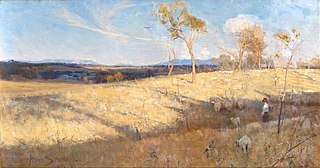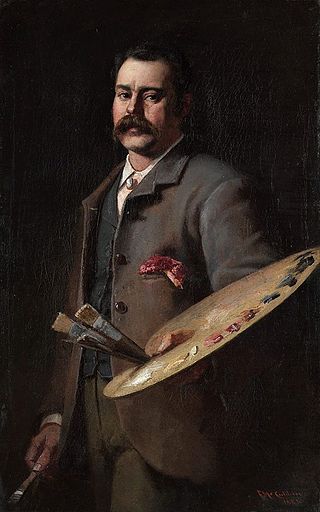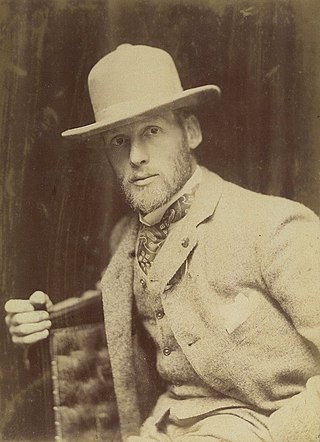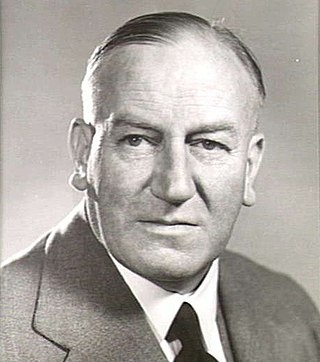
The Victorian Artists Society, which can trace its establishment to 1856 in Melbourne, promotes artistic education, art classes and gallery hire exhibition in Australia. It was formed in March 1888 when the Victorian Academy of Arts and the Australian Artists' Association amalgamated.

Australian art is a broad spectrum of art created in or about Australia, or by Australians overseas, spanning from prehistoric times to the present day. The art forms include, but are not limited to, Aboriginal, Colonial, Landscape, Atelier, and Contemporary art.

The Heidelberg School was an Australian art movement of the late 19th century. It has been described as Australian impressionism.

Frederick McCubbin was an Australian artist, art teacher and prominent member of the Heidelberg School art movement, also known as Australian impressionism.

Thomas William Roberts was an English-born Australian artist and a key member of the Heidelberg School art movement, also known as Australian impressionism.

Charles Edward Conder was an English-born painter, lithographer and designer. He emigrated to Australia and was a key figure in the Heidelberg School, arguably the beginning of a distinctively Australian tradition in Western art.

Sir Arthur Ernest Streeton was an Australian landscape painter and a leading member of the Heidelberg School, also known as Australian Impressionism.

Margaret Rose Preston was an Australian painter and printmaker who is regarded as one of Australia's leading modernists of the early 20th century. In her quest to foster an Australian "national art", she was also one of the first non-Indigenous Australian artists to use Aboriginal motifs in her work. Her works are distinctively signed MP.

The 9 by 5 Impression Exhibition was an art exhibition held in Melbourne, Victoria, Australia. It opened on 17 August 1889 at Buxton's Rooms on Swanston Street and featured 183 "impressions", the majority of which were painted by Charles Conder, Tom Roberts and Arthur Streeton, three leading members of the Heidelberg School art movement, also known as Australian impressionism. Two other members, Frederick McCubbin and Charles Douglas Richardson, made smaller contributions.

Mosman is a suburb on the Lower North Shore region of Sydney, in the state of New South Wales, Australia. Mosman is located 8 kilometres north-east of the Sydney central business district and is the administrative centre for the local government area of the Municipality of Mosman.

Curlew Camp was an artists' camp established in the late 19th century on the eastern shore of Little Sirius Cove, now part of Greater Sirius Cove in Sydney. It was home for some years to several leading Australian artists, such as Arthur Streeton and Tom Roberts of the Heidelberg School, and it was from here that some of their most famous paintings were created. Today the site is still in its natural state and the Mosman Council has built a foreshore walk called the "Curlew Camp Artist's Walk" which traces the journey that the residents of the camp followed when they disembarked from the ferry at South Mosman ferry wharf, then known as "Musgrave Street Wharf," and returned to the camping site. The walk starts at the wharf and continues along the harbour's edge for 1.6 km until it finishes at Taronga Zoo Wharf.
Piers Maxwell Dudley-Bateman was an Australian landscape painter. He was a member of The Antipodeans, a group of Melbourne painters that also included Arthur Boyd, David Boyd, Charles Blackman, John Brack, Robert Dickerson, John Perceval and Clifton Pugh. He taught as a Professor for painting at the Shanghai Institute of Visual Art under Fudan University in Shanghai, China.

Golden Summer, Eaglemont is an 1889 landscape painting by Australian artist Arthur Streeton. Painted en plein air at the height of a summer drought, it is an idyllic depiction of sunlit, undulating plains that stretch from Streeton's Eaglemont "artists' camp" to the distant blue Dandenong Ranges, outside Melbourne. Naturalistic yet poetic, and a conscious effort by the 21-year-old Streeton to create his grandest work yet, it is a prime example of the artist's distinctive, high-keyed blue and gold palette, what he considered "nature's scheme of colour in Australia".

Howard Hinton was an Australian art patron and benefactor. A thwarted artist due to shortsightedness, he visited many of the great galleries of Europe in his youth. At age 24 he migrated to Australia and quickly associated with leading artists of the Heidelberg School and the bohemian artists' camps around Sydney Harbour in the 1890s. He built a successful career in shipping and, along with a family inheritance, used his moderate wealth to support waves of Australian artists in the first half of the twentieth century. Through extensive donations to the Art Gallery of New South Wales and particularly the Armidale Teachers' College he became one of the greatest benefactors in Australian art history.

Leon Pole was an Australian artist who was associated with the Heidelberg School art movement, also known as Australian Impressionism.

Louis Abrahams was a British-born Australian tobacconist, art patron, painter and etcher associated with the Heidelberg School art movement, also known as Australian Impressionism.

The Exhibition of Australian Art in London was a show organised by the trustees of the Art Gallery of New South Wales (AGNSW), notably Julian Ashton, and financially supported by the philanthropist Eadith Walker. Held at London's Grafton Galleries between April and September 1898, it featured 371 artworks made in Australia by 114 artists, and was the first major exhibition of Australian art to occur internationally.

John Llewellyn Jones, often referred to as Llewellyn or J. Llewellyn Jones, was an Australian artist and photographer who was associated with the Heidelberg School art movement, also known as Australian impressionism.

Thomas Humphrey was a Scottish-born Australian artist and photographer who was associated with the Heidelberg School art movement, also known as Australian impressionism.

Harold Brocklebank Herbert (1891–1945) was an early 20th century Australian painter and printmaker, an illustrator and cartoonist. A traditionalist, as an art teacher he promoted representational painting, and as a critic was an influential detractor of modernism. He was the first war artist to be appointed for Australia in the Second World War, serving for 6 months with the Australian Infantry Forces in Egypt in 1941 and in the Middle East in 1942.
























